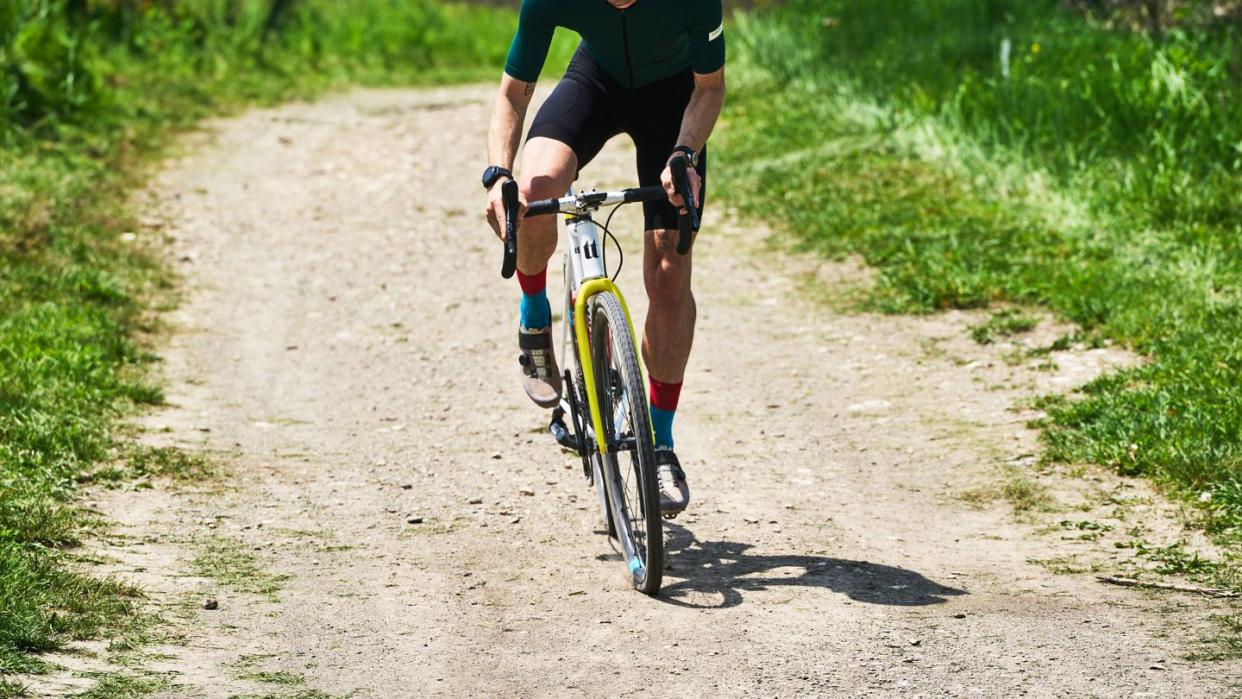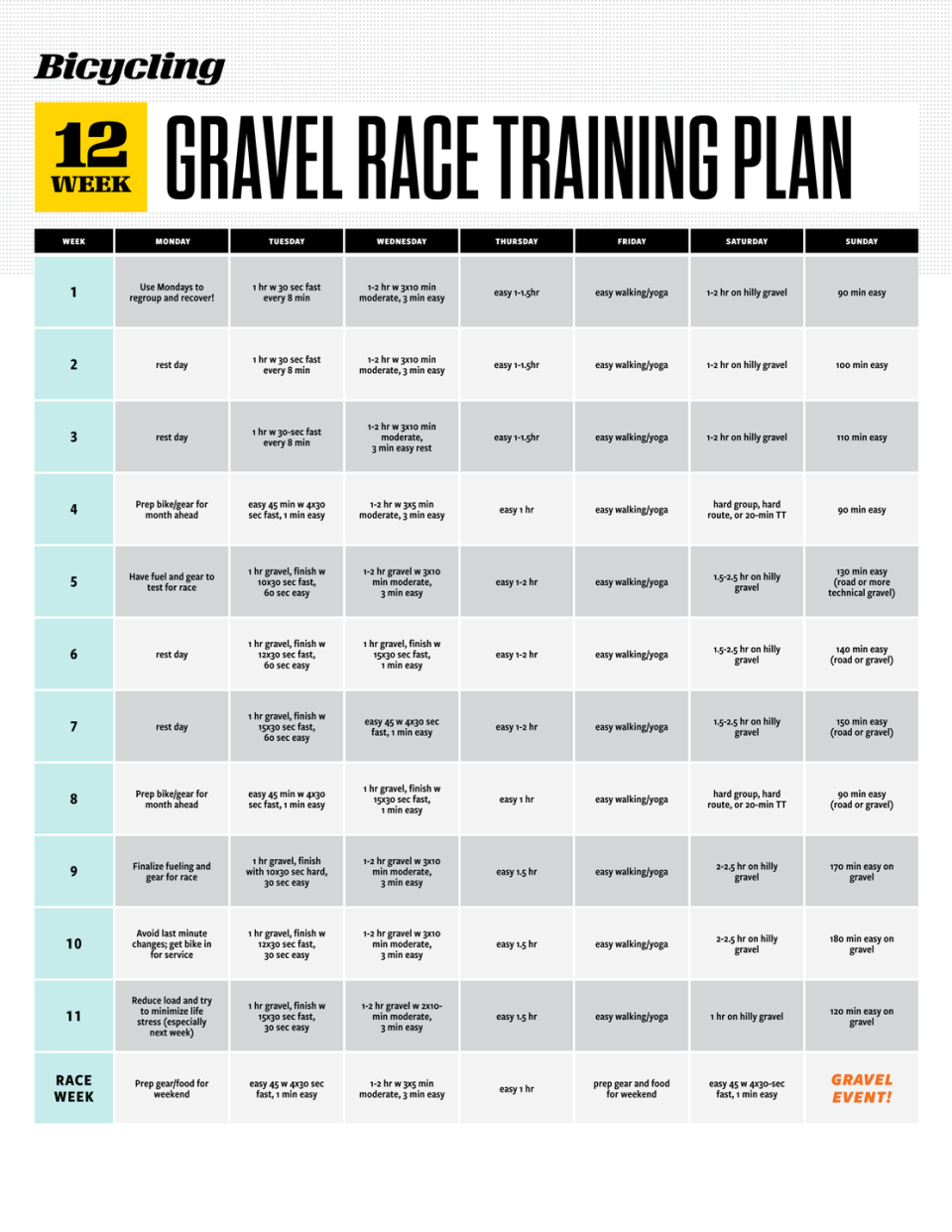Your 12-Week Gravel Training Plan to Crush Your First Race

"Hearst Magazines and Yahoo may earn commission or revenue on some items through these links."
Gravel racing is a perfect entry to cycling events: You can ride with other people in the race, or ride solo. You can take your time at aid stations or blaze right through. You can walk the super technical sections, or blast through that creek crossing with no regard for your bottom bracket. It’s dirty, gritty, and a ton of fun.
To get you ready for your first race, we talked to Rebecca Rusch, longtime ultra-endurance cyclist, the founder of Rebecca’s Private Idaho, and creator of the Rusch Academy, which has tons of online resources and courses for anyone seeking gravel expertise. We got her best tips for training and getting ready for race day, plus we have a 12-week training plan to set you up for a successful first gravel grinder.
Your 12-Week Gravel Ride Training Plan
Longtime off-road cycling coach Peter Glassford of ConsummateAthlete.com put together this simple 12-week plan, designed for gravel races from 50 to 75 miles in length.
One important reminder before you get started: The more time you spend riding outside versus indoors on the trainer, the better prepared you’ll be for race day. “A lot of athletes rarely do their intervals in the environment they race,” Glassford says. “With the advent of indoor training software making it easy to do intervals exactly at the right power, there is a perception that ‘perfect’ means their power intervals are 100 percent in the zone and look pretty in a graph.” But really, you want intervals that match the environment in which you’ll race.
“You can ride the trainer when you need to, but get outside when you can,” Glassford adds. “That way, on race day you are able thrive in that environment versus getting intimidating or making technical errors. An example would be doing intervals on a gravel hill that challenges you to find traction, shift, and deal with bumps and that you are going to descend in your recoveries to work on technical skills.”

Workouts on Your Gravel Training Plan
Easy Rides: These are the rides you could do for a long time. You should be able to talk in sentences and keep steady pedaling—minimize coasting and sprinting. Go for road rides or smooth gravel for these easy sessions.
Moderate Pace: This is not maximal effort; you should be able to say words but not full sentences with heart rate around 80 to 90 percent of max.
Fast Intervals: Accelerate athletically, and ride smooth and fast—but don’t go all out. This isn’t max effort or sprinting.
Hilly Route: Pick a gravel route that has several hills on it. Try to mix it up and practice navigating. This could also be a group ride at your level.
Sunday Long Ride: Choose a smoother route. Practice fueling and keep legs moving for extended time, with minimal stopping.
Hard Group, Hard Route, 20-Min TT: Choose what works best for you, but make this a harder day to simulate racing and get some feedback on your progress. For the time-trial, go hard and try to keep your effort steady—not going up and down.
5 Tips for Conquering Your First Gravel Race
1. Don’t Stress
When people think of bike races, the Tour de France often comes to mind and they imagine elite riders surrounding them and getting left in the dust. “Gravel events are so awesome, because they’re not at all like that,” Rusch says. “Yes, some have professional racers, but that’s such a small percentage of the racing.”
Gravel riding is often more about the exploration than the finish time. You can train in your own backyard and then choose a race based on a place you want to visit and see by bike. “Think of [a gravel race] less as a race and more as an event that is just plug-and-play,” Rusch adds. “There are lodging options, they tell you where to eat, they tell you the route, they provide aid stations and support. It’s a nice way to go exploring, but not feel stressed about being on your bike alone in an unknown place.”
2. Do Some Research
You might initially choose a race based on location and timing, but Rusch suggests also looking at the vibe of the event. “Is the event more grassroots, is it a fundraiser, is it a huge field and really professional?” she asks.
You can do some light internet stalking of a race’s social media page, website, and past race photos to get a sense of what vibe the race has before committing.
Also, check a race’s elevation profile in addition to the distance: If your race has a lot of hills, you’ll want to train on plenty of ups and downs so you’re ready for race day. You can also search for race reports from past years to get a sense of how technical a course is, how good the aid stations are, and any helpful tips, like how to secure the best parking spot.
3. Control the Controllable
The night before the race, lay out all of your gear, from food/drink to your bike setup (charge those electronic shifters!) to your clothing for the day (including bad weather gear and a post-race change of clothing!). Check the weather report and pack accordingly—and always have an extra layer or two in your bag in case the weather changes abruptly en route to the race. “Think like you’re packing for a kindergartener on his first day of school,” says Rusch.
If possible, pick up your race plate or bib number the day before and do a quick shakeout ride scoping out where parking for the race is, as well as the first couple miles of the course, says Rusch. That way, you won’t be as stressed on the start line thinking of all the unexpected terrain to come.
4. Check Finish Times
Rusch suggests scanning past results of finishers in your age/gender group to get a sense of how long the race is going to take. “That helps you plan your food, and it helps you wrap your head around how long you’ll be out there,” she says.
Once you have a rough idea of how long you might be out there, you can make a nutrition and hydration plan, so you know how many bottles of water you’ll drink (aim for one per hour at least) and how many calories you’ll need to take in (anywhere from 200 to 400 calories per hour).
5. Be Smart About Gear
You don’t need an entirely new gravel racing setup to get started. Many riders will do their first race on an old mountain bike or cyclocross bike, or even a road bike with the beefiest tires it will fit. But once you’re hooked, the gravel-specific gear is fun to play with.
Rusch is a big fan of dialing in tire pressure as well as the contact points on your bike to optimize for comfort as well as speed. She likes the ENVE tire pressure calculator to dial in tire pressure, and recommends adding extra cushion where possible on your bike. This may mean thicker bar tape or padded gloves, a slightly cushier saddle than your road bike had, and even extra insoles for your shoes—all of these additions help dull the vibrations and bumps of the gravel road. “You’re riding a rigid bike on a bumpy surface,” she points out. “Any way to add a bit of shock absorption helps.”
You Might Also Like

